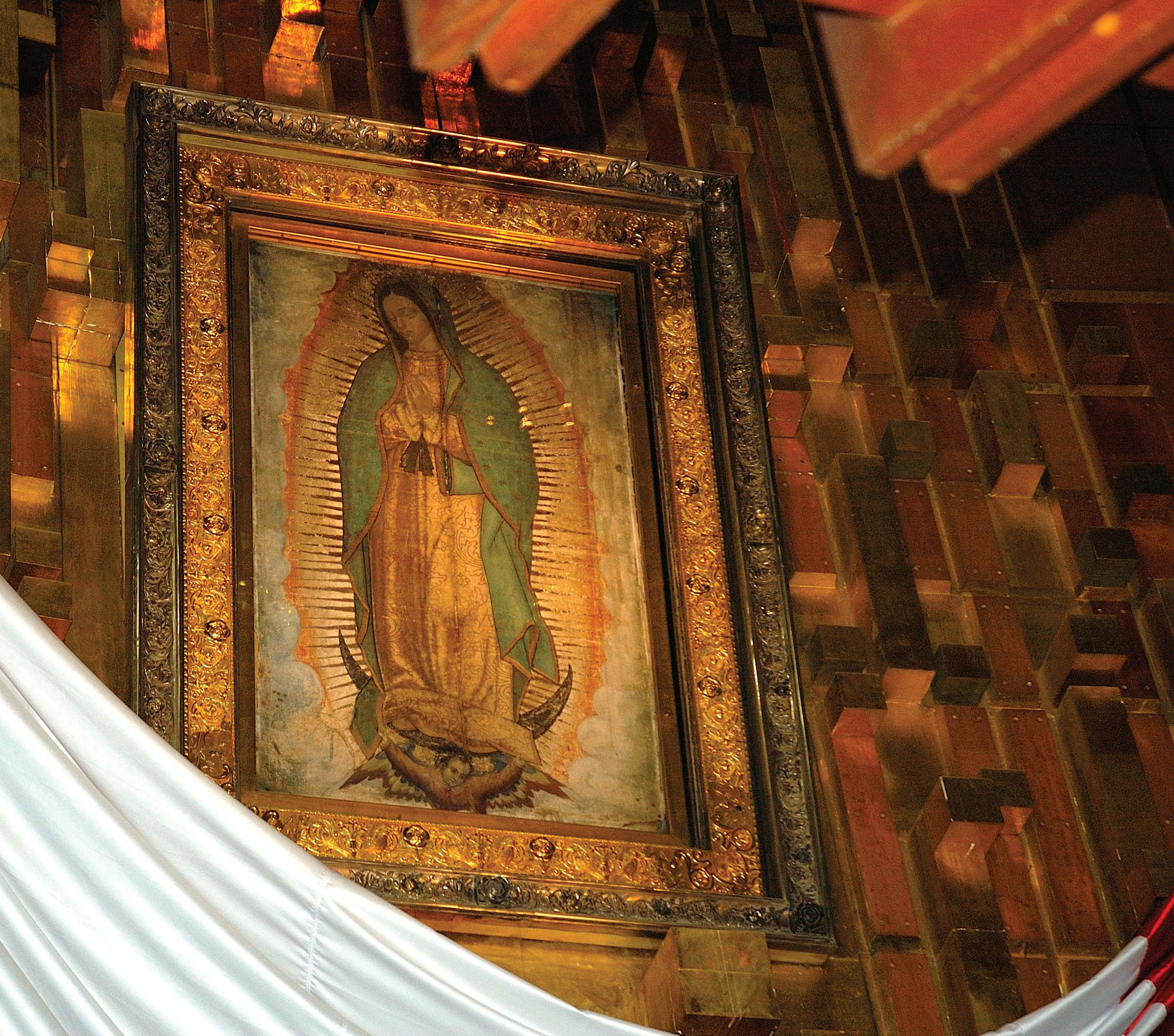
5 minute read
COVER STORY: Our Lady of Guadalupe Patroness of the Americas
Our Lady of Guadalupe,

Advertisement
For nearly 600 years, the appearance of the Virgin Mary to St. Juan Diego in Mexico has captivated countless hearts and minds worldwide.
With bowed head, brown skin, and wearing a blue-green robe studded with stars, Our Lady of Guadalupe is instantly recognizable and one of the most iconic images associated with Catholicism. Despite the widespread fame of this Marian apparition, its origins are quite humble and deeply connected to the identity of indigenous people in Mexico and beyond. The story begins 490 years ago in 1531 in Mexico City, a New World metropolis recently conquered by the Spanish.
Juan Diego, an indigenous man who had converted to Christianity, would make regular visits to a Franciscan mission for religious education, typically passing by Tepeyac Hill. On the morning of December 9, as he walked past the hill, the Virgin Mary appeared before him with a message: Request that the bishop have a chapel built in her name in this location as a place for those in need to pray for her intercession. After two more Marian apparitions—and a demand for proof from Bishop Juan de Zumárraga—on

By Daniel Imwalle

December 12, Juan once again encountered Our Lady, who uttered these famous words: “Am I not here, I who am your mother?” She instructed Juan to gather flowers, and when he did, she arranged them in his tilma, or cloak.
When Juan returned to tell Bishop Zumárraga about this latest encounter, he opened his tilma, the flowers fell onto the floor before the prelate, and emblazoned upon Juan’s cloak was an image of the Virgin Mary. Being the culmination of the four Marian appearances to Juan Diego, December 12 is the feast of Our Lady of Guadalupe.
Now, there is not only a chapel built in her honor on the Hill of Tepeyac, but also two basilicas. Construction on the original basilica began in the late 1600s and was completed in 1709. Built with heavy stone in the style of churches of that era, the old basilica slowly began
LEFT: On Tepeyac Hill, where Our Lady of Guadalupe appeared to Juan Diego in 1531, a bronze sculpture installation by Aurelio G.D. Mendoza titled The Offering shows 17 figures, including the Virgin Mary, Juan Diego, Bishop Juan de Zumárraga, and indigenous people bringing gifts to honor Our Lady. MIDDLE: The old Basilica of Our Lady of Guadalupe (foreground) has, until recently, been closed to the public due to its uneven foundation. The new basilica (background) was built to accommodate up to 10,000 people. RIGHT: In the days leading up to the feast day in 2020, thousands of faithful had already come to honor Mary by lighting a candle such as this one and offering prayers.

ABOVE: A painting of Juan Diego on display at the Cathedral of Our Lady of the Angels in Los Angeles shows flowers falling from his opened cloak. RIGHT: Draped with the Mexican flag below, the original cloak worn by Juan Diego hangs above the altar at the new basilica in Mexico City. BELOW: The connection between indigenous heritage and the Marian apparitions is strong, as evidenced by pilgrims wearing traditional indigenous clothing. to sink and become unstable, due to Mexico City being built on a dried-out lake bed. The second basilica, built to handle the fluctuating earth underneath, opened its doors in 1976. The original tilma worn by Juan Diego is on display in the new basilica.
Well before the construction of the basilicas, the site was already venerated as a place of pilgrimage, even dating back to the year of the apparitions themselves—1531. Now it is the most visited Catholic pilgrimage site in the world, and the third most visited sacred site across all religions. Before the COVID-19 pandemic, around 10 million people visited the Shrine of Our Lady of Guadalupe each year.
LEFT: CNS PHOTO/COURTESY ARCHDIOCESE OF LOS ANGELES; RIGHT: STEVLER/ISTOCK
BOTTOM: OCTAVIO DURAN, OFM





LEFT: Dancers in colorful garb perform at a celebration of Our Lady of Guadalupe at the Los Angeles Memorial Coliseum in 2012. The event commemorated the 10th anniversary of the canonization of Juan Diego in 2002. MIDDLE: The diaspora of Our Lady of Guadalupe celebrations has continued to spread in the United States. A woman wearing a traditional Aztec headdress participates in a ceremony honoring the Virgin in Houston in December 2019. UPPER RIGHT: Pope Francis burns incense on the feast of Our Lady of Guadalupe at the Vatican in 2019. In his homily, the pope said, “May she speak to us as she spoke to Juan Diego with these three titles: with tenderness, with feminine warmth, and with a closeness of ‘mixedness.’”
The facts that Our Lady of Guadalupe has mestizo—a combination of European and indigenous—features, and that she chose to appear to an indigenous person have long held an important place in the Mexican identity. She also reportedly spoke to Juan Diego in his native tongue, Nahuatl. Outside of Mexico, Our Lady of Guadalupe is honored by millions in the United States, other countries in Latin America, and beyond. In Los Angeles, for example, an annual procession honoring the Virgin of Guadalupe has taken place since 1931. In cities and towns across the United States, more and more festivities and processions are popping up each year. So although this feast is thoroughly rooted in Mexico, it’s no surprise that Our Lady of Guadalupe is the Patroness of the Americas.
Daniel Imwalle is the managing editor of St. Anthony Messenger. Having traveled many times to Mexico with his wife, Belinda, who is from Mexico City, he is grateful for having had the opportunity to visit the Shrine of Our Lady of Guadalupe, among other national historic sites.














